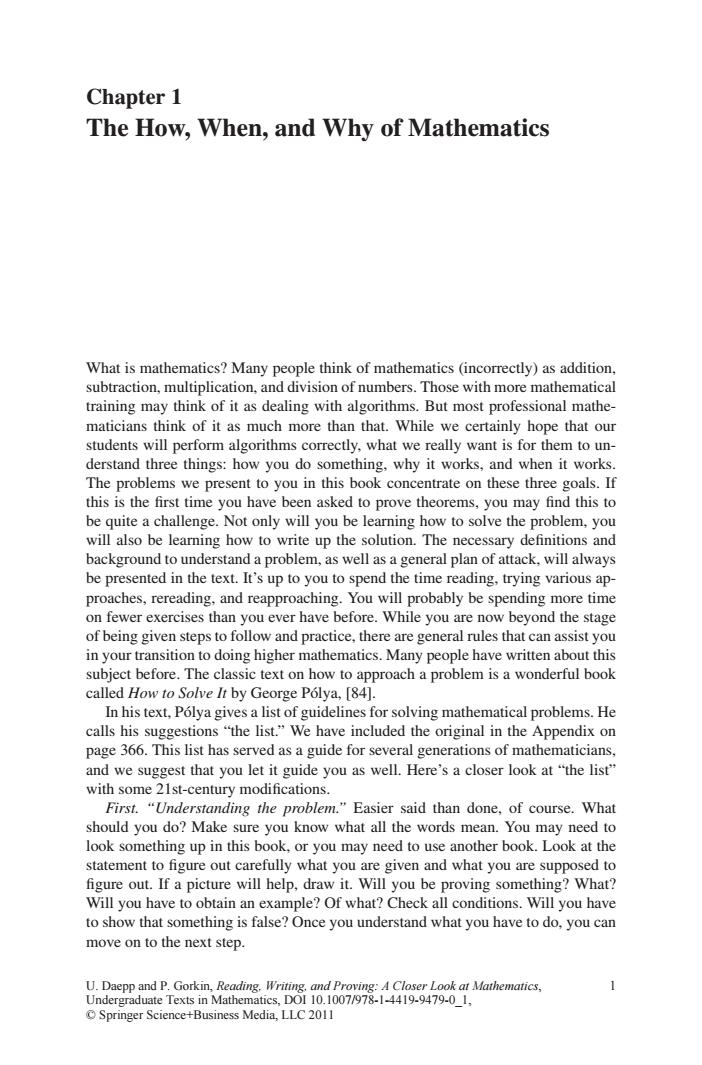正在加载图片...

Chapter 1 The How,When,and Why of Mathematics What is mathematics?Many people think of mathematics (incorrectly)as addition, subtraction,multiplication,and division of numbers.Those with more mathematical training may think of it as dealing with algorithms.But most professional mathe- maticians think of it as much more than that.While we certainly hope that our students will perform algorithms correctly,what we really want is for them to un- derstand three things:how you do something,why it works,and when it works The problems we present to you in this book concentrate on these three goals.If this is the first time you have been asked to prove theorems,you may find this to be quite a challenge.Not only will you be learning how to solve the problem,you will also be learning how to write up the solution.The necessary definitions and background to understand a problem,as well as a general plan of attack,will always be presented in the text.It's up to you to spend the time reading,trying various ap- proaches,rereading,and reapproaching.You will probably be spending more time on fewer exercises than you ever have before.While you are now beyond the stage of being given steps to follow and practice,there are general rules that can assist you in your transition to doing higher mathematics.Many people have written about this subject before.The classic text on how to approach a problem is a wonderful book called How to Solve It by George Polya,[84]. In his text,Polya gives a list of guidelines for solving mathematical problems.He calls his suggestions"the list."We have included the original in the Appendix on page 366.This list has served as a guide for several generations of mathematicians, and we suggest that you let it guide you as well.Here's a closer look at"the list" with some 21st-century modifications. First."Understanding the problem."Easier said than done,of course.What should you do?Make sure you know what all the words mean.You may need to look something up in this book,or you may need to use another book.Look at the statement to figure out carefully what you are given and what you are supposed to figure out.If a picture will help,draw it.Will you be proving something?What? Will you have to obtain an example?Of what?Check all conditions.Will you have to show that something is false?Once you understand what you have to do,you can move on to the next step. U.Daepp and P.Gorkin,Reading.Writing,and Proving:A Closer Look at Mathematics, Undergraduate Texts in Mathematics,DOI 10.1007/978-1-4419-9479-0_1, Springer Science+Business Media,LLC 2011Chapter 1 The How, When, and Why of Mathematics What is mathematics? Many people think of mathematics (incorrectly) as addition, subtraction, multiplication, and division of numbers. Those with more mathematical training may think of it as dealing with algorithms. But most professional mathematicians think of it as much more than that. While we certainly hope that our students will perform algorithms correctly, what we really want is for them to understand three things: how you do something, why it works, and when it works. The problems we present to you in this book concentrate on these three goals. If this is the first time you have been asked to prove theorems, you may find this to be quite a challenge. Not only will you be learning how to solve the problem, you will also be learning how to write up the solution. The necessary definitions and background to understand a problem, as well as a general plan of attack, will always be presented in the text. It’s up to you to spend the time reading, trying various approaches, rereading, and reapproaching. You will probably be spending more time on fewer exercises than you ever have before. While you are now beyond the stage of being given steps to follow and practice, there are general rules that can assist you in your transition to doing higher mathematics. Many people have written about this subject before. The classic text on how to approach a problem is a wonderful book called How to Solve It by George Polya, [84]. ´ ´ calls his suggestions “the list.” We have included the original in the Appendix on and we suggest that you let it guide you as well. Here’s a closer look at “the list” First. “Understanding the problem.” Easier said than done, of course. What look something up in this book, or you may need to use another book. Look at the figure out. If a picture will help, draw it. Will you be proving something? What? Will you have to obtain an example? Of what? Check all conditions. Will you have to show that something is false? Once you understand what you have to do, you can move on to the next step. 1 should you do? Make sure you know what all the words mean. You may need to page 366. This list has served as a guide for several generations of mathematicians, statement to figure out carefully what you are given and what you are supposed to with some 21st-century modifications. © Springer Science+Business Media, LLC 2011 U. Daepp and P. Gorkin, Reading, Writing, and Proving: A Closer Look at Mathematics, In his text, Polya gives a list of guidelines for solving mathematical problems. He Undergraduate Texts in Mathematics, DOI 10.1007/978-1-4419-9479-0_1